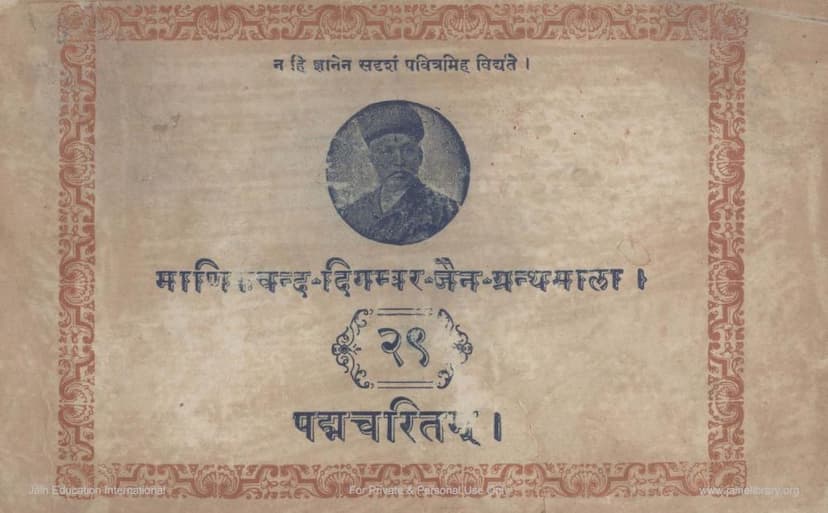Padmacharitam Part 01
Added to library: September 2, 2025

Summary
This is a comprehensive summary of the provided Jain text, "Padmacharitam Part 01," authored by Ravishenacharya and edited by Darbarilal Nyayatirth, published by Manikchand Digambar Jain Granthamala Samiti.
Overview:
"Padmacharitam Part 01" is the first volume of the "Padmacharitam," a significant work within the Digambara Jain tradition. Despite being widely known as "Padmapurana," its true title is "Padmacharitam," as it narrates the life and deeds of Padmamuni, another name for Lord Rama. The text is considered the most ancient available narrative work (Prathamanuyoga) in the Digambara Jain sect.
Key Information and Content:
-
Author and Editor: The work is attributed to Acharya Ravishena. The present edition has been meticulously revised and edited by Pandit Darbarilal Nyayatirth, a Sahitya Ratna.
-
Publisher: The publication is credited to the Manikchand Digambar Jain Granthamala Samiti.
-
Title and Content: The book's actual title is "Padmacharitam," meaning the "Charitra" or life story of Padmamuni, who is also known as Purushottam Ramchandra.
-
Historical Context and Dating:
- The text was composed 1203 years after the Nirvana of Lord Mahavir.
- Based on the inscription "द्विशताभ्यधिके समासहस्त्रे समतीतेऽर्धचतुर्थवर्षयुक्ते । जिनभास्करवर्द्धमानसिद्धे चरितं पद्ममुनेरिदं निबद्धम् ॥" (which indicates completion in the 1200th year, plus 470 years, plus 3.5 years, after Jin Bhaskara Vardhamana's Siddhi), the composition can be placed approximately 470 years after the start of the Vikram Samvat era.
- If Vikram Samvat began 470 years after Vir Nirvana, then the composition date is estimated to be Vikram Samvat 834.
- This dating makes "Padmacharitam" slightly older than Acharya Jinasena's Harivansh Purana (completed in Vikram Samvat 840). The Harivansh Purana itself references Ravishena's "Padmodaya," suggesting Ravishena's work predates it.
- Acharya Udyotana Suri also mentions Ravishena's "Padmacharita" and "Varangcharita" in his Prakrit work "Kuvalayamala" (composed in Vikram Samvat 835, which corresponds to the 700s in Shak Samvat).
-
Author's Guru Parampara: Acharya Ravishena traces his lineage through Indraguru, Divakarayyati, Arhanmuni, Lakshmanasena, and finally Ravi.
-
Absence of Sangh Division: The text does not mention any specific Sangh or Gana affiliation for Ravishena, indicating that the divisions within the Digambara tradition (like Deva, Nandi, Sena, Simha Sanghs) were not clearly defined or had not yet emerged at the time of its composition.
-
Other Works of Ravishena: While only "Padmacharitam" is currently available, the Harivansh Purana mentions Ravishena's "Varangcharita," although this work has not been found.
-
Publication Significance: The publisher deemed it crucial to publish the original text, as previously only Hindi translations (Vachanika) were available, causing difficulties for scholars needing to reference the original for evidence and research.
-
Volume Structure: This first volume comprises approximately 500 pages. The entire work is expected to be completed in two more volumes of similar size. The estimated cost for the complete set is around five rupees.
-
Content Overview (Based on Chapter List): The preface and index indicate that the book is divided into numerous "Parvas" (chapters). Part 1 (first volume) includes chapters like:
- Sutravidhanam (Rules and Regulations)
- Shrenikarchitabhidhanam (Praise of Shrenika)
- Vidyadharalokabhidhanam (Realm of the Vidyadharas)
- Rishabha Mahatmya (Glory of Rishabha)
- Rakshasavanshabhidhanam (Lineage of Rakshasas)
- Vanaravanshabhidhanam (Lineage of Vanaras)
- Dashagrivabhidhanam (On Dashagriva/Ravana)
- Valinirvanabhidhanam (Nirvana of Vali)
- Dashagriva Prasthane Sahasrarashymanaranyashramanyabhidhanam (Dashagriva's Journey and the Ashram of Sahasrarashmi)
- Marutta Yajñadhvansanapadānugābhividhanam (Destruction of Marutta's Sacrifice)
- Indraparābhidhanam (Defeat of Indra)
- Indranirvanābhidhanam (Nirvana of Indra)
- Anantabaladharmābhidhanam (Glory of Anantabala Dharma)
- Anjanasundari Vivaha (Marriage of Anjanasundari)
- Pavanāñjanā Sambhoga and Pavānāñjanā Samāgama (Union and Meeting of Pavana and Anjana)
- Ravana Samrajyabhidhanam (Empire of Ravana)
- Tirthankaradi Bhavānukīrtanam (Account of Tirthankaras' lives)
- Subrata Vajrabahu Kīrti Mahatmya Varnanam (Glory of Subrata, Vajrabahu, Kirti)
- Sukośala Mahatmya Yukta Dasharatha Upapatyabhidhanam (Dasharatha's story related to Sukośala's glory)
- Bibhishana Vyasanavarnanam (Calamity of Vibhishana)
- Kekayāvara Pradāna (Grant of Boon to Kekaya)
- Chaturbhṛtrusambhava Abhidhanam (Birth of the Four Brothers)
-
Mangalacharan (Invocation): The text begins with verses praising Lord Mahavir and then invokes all the Tirthankaras, starting from Rishabha and ending with Parshva. It emphasizes the purity of knowledge and the importance of reciting the deeds of great souls for spiritual progress and the attainment of merit.
-
Narrative Style: The text employs poetic language and philosophical discourse, extolling the virtues of righteous conduct and the consequences of negative actions. It uses vivid imagery to describe celestial beings, kings, and the world.
Key Themes:
- Adherence to Jain principles: The narrative consistently highlights the importance of right faith (Samyak Darshan), right knowledge (Samyak Gyan), and right conduct (Samyak Charitra).
- Karma and Rebirth: The text illustrates the intricate workings of karma and its impact on the cycle of birth, death, and rebirth across different realms of existence.
- Virtues and Vices: It contrasts righteous actions with sinful deeds, showcasing the path to liberation through asceticism, detachment, and adherence to vows.
- The Role of Great Souls: The lives and teachings of Tirthankaras and other virtuous beings are presented as exemplars for followers.
- Cosmology: The text includes descriptions of the Jain cosmology, including the structure of the universe, continents, and heavens.
Overall Significance:
"Padmacharitam Part 01" serves as a foundational text for understanding Jain mythology and philosophy through its narrative. Its historical accuracy and comprehensive coverage of early Jain literature make it an invaluable resource for scholars and practitioners alike, offering insights into the Jain worldview and the ethical teachings that guide adherents towards spiritual enlightenment.